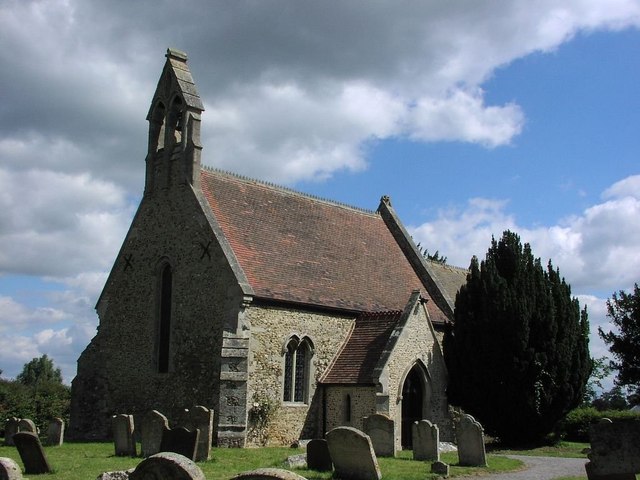|
Old Bedford River
The Old Bedford River is an artificial, partial diversion of the waters of the River Great Ouse in the Fens of Cambridgeshire, England. It was named after the fourth Earl of Bedford who contracted with the local Commission of Sewers to drain the Great Level of the Fens beginning in 1630. It provided a steeper and shorter path for the waters of the Great Ouse, and was embanked to prevent them flooding the low ground of the South Fens. Throughout the project, the Earl and his Adventurers faced disruption from those who were opposed to drainage schemes. The project was deemed to have succeeded in draining the fens in 1637, but that decision was reversed in 1638. After a lull during the English Civil War, when much of the work was damaged, the Dutch engineer Cornelius Vermuyden worked with William Russell, the fifth Earl of Bedford to complete the drainage. Disruption and unrest continued while the work was carried out, resulting in the Adventurers employing armed guards. A secon ... [...More Info...] [...Related Items...] OR: [Wikipedia] [Google] [Baidu] |
Mepal
Mepal is a village in Cambridgeshire, England. Mepal is part of the East Cambridgeshire district, and is located just north of the A142 road between Ely and Chatteris. History First recorded at the start of the 13th century Mepal's history has always been tied up with that of The Fens and the village is less than ten metres above sea level. One of the smaller villages of the Isle of Ely, Mepal lies at the western end of the Isle on what was once the shore between the fenland and the higher ground of the Isle.About Mepal The and the |
Ely, Cambridgeshire
Ely ( ) is a cathedral city in the East Cambridgeshire district of Cambridgeshire, England, about north-northeast of Cambridge and from London. Ely is built on a Kimmeridge Clay island which, at , is the highest land in the Fens. It was due to this topography that Ely was not waterlogged like the surrounding Fenland, and was an island separated from the mainland. Major rivers including the River Witham, Witham, River Welland, Welland, River Nene, Nene and River Great Ouse, Great Ouse feed into the Fens and, until draining commenced in the eighteenth century, formed freshwater marshes and Mere (lake), meres within which peat was laid down. Once the Fens were drained, this peat created a rich and fertile soil ideal for farming. The River Great Ouse was a significant means of transport until the Fens were drained and Ely ceased to be an island in the seventeenth century. The river is now a popular boating spot, and has a large marina. Although now surrounded by land, the city ... [...More Info...] [...Related Items...] OR: [Wikipedia] [Google] [Baidu] |
Ruston (engine Builder)
Ruston & Hornsby was an industrial equipment manufacturer in Lincoln, England founded in 1918. The company is best known as a manufacturer of narrow and standard gauge diesel locomotives and also of steam shovels. Other products included cars, steam locomotives and a range of internal combustion engines, and later gas turbines. It is now a subsidiary of Siemens. Background Proctor & Burton was established in 1840, operating as millwrights and engineers. It became Ruston, Proctor and Company in 1857 when Joseph Ruston joined them, acquiring limited liability status in 1899. From 1866 it built a number of four and six-coupled tank locomotives, one of which was sent to the Paris Exhibition in 1867. In 1868 it built five 0-6-0 tank engines for the Great Eastern Railway to the design of Samuel Waite Johnson. Three of these were converted to crane tanks, two of which lasted until 1952, aged eighty-four. Among the company's output were sixteen for Argentina and some for T. A. Walke ... [...More Info...] [...Related Items...] OR: [Wikipedia] [Google] [Baidu] |
Gwynnes Limited
Gwynnes Limited was a City of London England engineering business, iron founders and pump makers founded in 1849 to capitalise on the centrifugal pump inventedThe first practical centrifugal pump called the Massachusetts pump was built in the United States in 1818. In 1830 a pump having a fairly good efficiency was built by McCarty at the dock yards of New York. About 1846 centrifugal pumps began to be manufactured in England by Appold Thompson and Gwynne. Appold improved the pump by the addition of curved vanes in 1849. (page 10, R L Daugherty (prof. Hydraulics, Cornell U.) '’Centrifugal Pumps'’, McGraw-Hill, New York 1915)John Gwynne bought Andrews USA 1846 patent and introduced it to England. Lloyd took out a fan patent in 1848 and J G Appold began the manufacture of almost the same fan. John Gwynne did not trouble to patent various improvements but applied for a new patent in 1850 though the patent agent made a mistake and the patent is dated 1851. In 1854 J E A Gwynne obt ... [...More Info...] [...Related Items...] OR: [Wikipedia] [Google] [Baidu] |
Butterley Company
The Butterley Company was an English manufacturing firm founded as Benjamin Outram and Company in 1790. Its subsidiaries existed until 2009. Origins This area of Derbyshire had been known for its outcrops of iron ore which had been exploited at least since the Middle Ages. After the Norman Conquest, nearby Duffield Frith was the property of the de Ferrers family who were iron masters in Normandy. In 1793, William Jessop, with the assistance of Benjamin Outram, constructed the Cromford Canal to connect Pinxton and Cromford with the Erewash Canal. In digging Butterley Tunnel for the Cromford Canal, coal and iron were discovered. Fortuitously, Butterley Hall fell vacant and in 1790 Outram, with the financial assistance of Francis Beresford, bought it and its estate. The following year Outram and Beresford were joined by Jessop and John, the grandson of Ichabod Wright, a wealthy Nottingham banker who was betrothed to Beresford's daughter and who owned the neighbouring Butter ... [...More Info...] [...Related Items...] OR: [Wikipedia] [Google] [Baidu] |
Huntingdonshire
Huntingdonshire (; abbreviated Hunts) is a non-metropolitan district of Cambridgeshire and a historic county of England. The district council is based in Huntingdon. Other towns include St Ives, Godmanchester, St Neots and Ramsey. The population was 180,800 at the 2021 Census. History The area corresponding to modern Huntingdonshire was first delimited in Anglo-Saxon times. Its boundaries have remained largely unchanged since the 10th century, although it lost its historic county status in 1974. On his accession in 1154 Henry II declared all Huntingdonshire a forest.H. R. Loyn, ''Anglo-Saxon England and the Norman Conquest'' 2nd ed. 1991, pp. 378–382. Status In 1889, under the Local Government Act 1888 Huntingdonshire became an administrative county, with the newly-formed Huntingdonshire County Council taking over administrative functions from the Quarter Sessions. The area in the north of the county forming part of the municipal borough of Peterborough became inst ... [...More Info...] [...Related Items...] OR: [Wikipedia] [Google] [Baidu] |
Bedford Level Corporation
The Bedford Level Corporation (or alternatively the Corporation of the Bedford Level) was founded in England in 1663 to manage the draining of the Fens of East Central England. It formalised the legal status of the Company of Adventurers previously formed by the Duke of Bedford to reclaim 95,000 acres of the Bedford Level. History The low-lying land of East Central England, known as the Fens, consisted traditionally of semi-continuous marshland and peat bog interspersed with isolated patches of higher ground. Agriculture has only been made possible by a co-ordinated system of drainage ditches. During medieval times this was controlled by the great monasteries in the area but fell into disrepute after the dissolution of the monasteries. By the 1600s the general drainage situation was so bad that King Charles I invited Cornelius Vermuyden, the Dutch engineer, to devise a scheme to drain the Great Fen. The Bedford Level The Great Fen, lying between the Wash and Cambridge, is more p ... [...More Info...] [...Related Items...] OR: [Wikipedia] [Google] [Baidu] |
Battle Of Dover (1652)
The naval Battle of Dover (also known as the Battle of Goodwin Sands), fought on 19 May 1652 (29 May 1652 Gregorian calendar), was the first engagement of the First Anglo-Dutch War between the navies of the Commonwealth of England and the United Provinces of the Netherlands. Background The English Parliament had passed the first of the Navigation Acts in October 1651, aimed at hampering the shipping of the highly trade-dependent Dutch. Agitation among the Dutch merchants had been further increased by George Ayscue's capture in early 1652 of 27 Dutch ships trading with the royalist colony of Barbados in contravention of an embargo. Both sides had begun to prepare for war, but conflict might have been delayed if not for an unfortunate encounter on 29 May 1652 (19 May in the Julian calendar then in use in England) near the Straits of Dover between a Dutch convoy escorted by 40 ships under Lieutenant-Admiral Maarten Tromp and an English fleet of 25 ships under General-at-Sea Rober ... [...More Info...] [...Related Items...] OR: [Wikipedia] [Google] [Baidu] |
Battle Of Dunbar (1650)
The Battle of Dunbar was fought between the English New Model Army, under Oliver Cromwell and a Scottish army commanded by David Leslie, on 3 September 1650 near Dunbar, Scotland. The battle resulted in a decisive victory for the English. It was the first major battle of the 1650 invasion of Scotland, which was triggered by Scotland's acceptance of Charles II as king of Britain after the beheading of his father, Charles I on 30 January 1649. After Charles I's execution, the English Rump Parliament established a republican Commonwealth in England. When their erstwhile ally, Scotland, recognised Charles II as king of all of Britain on 1 May 1650 and began recruiting an army to support him, the English dispatched the New Model Army, under the command of Cromwell. The army crossed into Scotland on 22 July, with a force of over 16,000 men. The Scots withdrew to Edinburgh, stripping the land of provisions. Cromwell attempted to draw the Scots out into a set piece battle, ... [...More Info...] [...Related Items...] OR: [Wikipedia] [Google] [Baidu] |
Ouse Washes
Ouse Washes is a linear biological Site of Special Scientific Interest stretching from near St Ives in Cambridgeshire to Downham Market in Norfolk. It is also a Ramsar internationally important wetland site, a Special Protection Area for birds, a Special Area of Conservation and a Nature Conservation Review site, Grade I. An area of between March and Ely is managed by the Wildlife Trust for Bedfordshire, Cambridgeshire and Northamptonshire and another area near Chatteris is managed by the Royal Society for the Protection of Birds. The Wildfowl & Wetlands Trust manages another area near Welney. The site lies between the Old Bedford River in the north-west and the New Bedford River in the south-east. The Washes are a flood storage area and are often under water in the winter. It is internationally significant for wintering and breeding wildfowl and waders, especially teal, pintail, Eurasian wigeon, shoveler, pochard and Bewick's swans. The site also has rich aquatic fauna and ... [...More Info...] [...Related Items...] OR: [Wikipedia] [Google] [Baidu] |







